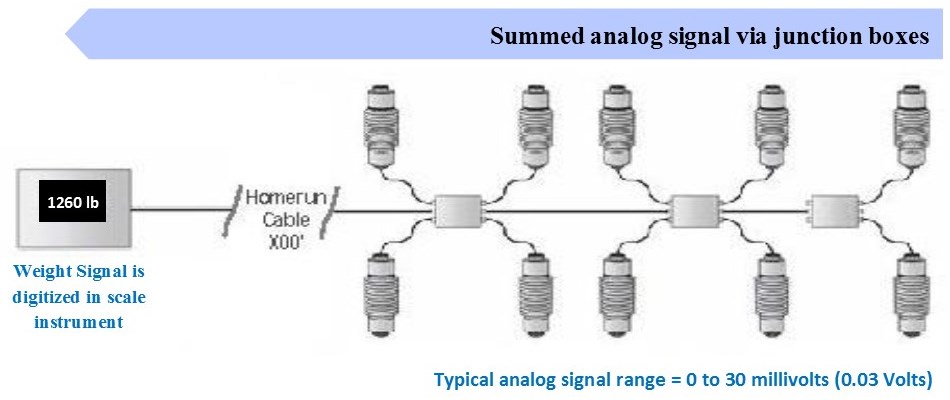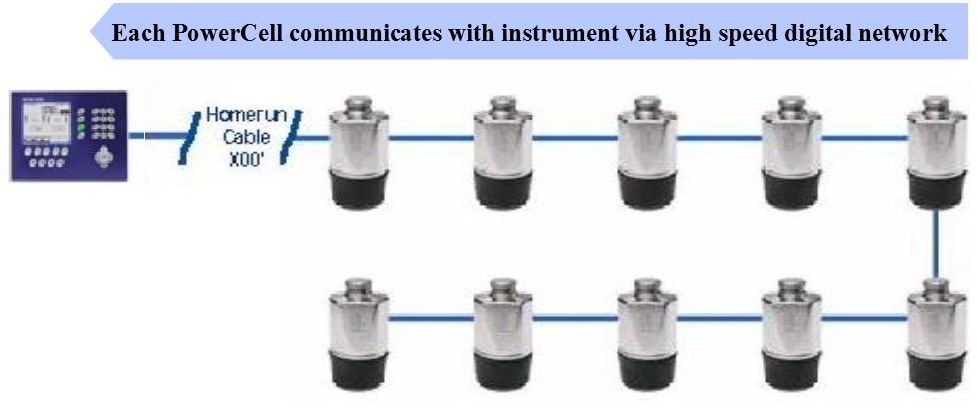The Difference Between Analog and Digital Load Cells
Essentially, the difference between an analog and a digital load cell is how the weighing signal is processed. Digital load cell systems differ from analog systems in three important ways: Signal strength, signal content, and data sample rate.
-
Signal Strength – in a digital load cell, the signals from the strain gauges (a device used to measure strain on an object) start as analog electrical voltages. A microprocessor inside of the load cell immediately converts them to digital signals. Those digital signals commonly use 2 to 6 volts as their signal range, which is less susceptible to fluctuation than the range of 0.03 volts in an analog cell. In other words, the digital signal is much stronger.
-
Signal Content – analog systems rely on the electrical voltage from the load cell to determine the weight reading. In contrast, digital systems transmit data from each load cell. The signal is composed of binary information (values of zero’s and ones) like computers use. Since the binary data is not susceptible to interference from radio frequencies, electromagnetics, temperature and other hazards, the binary data stream is more stable and less prone to weighing errors.
- Data Sample Rate – the data rate measures how quickly the load cell can send weight information. Analog load cells provide weight information continuously in real-time. Digital load cells send weight information in bits, many times per second.
Premier Scales & Systems offers a more advanced load cell technology called POWERCELL® PDX®. Mettler-Toledo’s POWERCELL® PDX® Load Cells combine the strain gauge and digital conversion in a stainless steel, hermetically sealed housing. Each cell can fine-tune the information before the final signal leaves the cell. They are also able to transmit additional information in addition to the weight reading, which allows the system to monitor its own health. This technology for load cells is more advanced than your typical digital load cells and is ideal for upgrading existing scales to improve weighing performance, reduce costly downtime, and simplify maintenance. The POWERCELL® PDX® Load Cells keep you continuously informed about your scale’s performance as well as provide you with the most accurate weight possible by continually adapting to common factors such as temperature, nonlinearity, hysteresis, voltage variation, and sensor creep, which affect all strain gauge load cells. Every minute that your scale weighs inaccurately or doesn’t weigh at all costs you money. POWERCELL® Load Cells have withstood the most extreme forces of nature for more than 20 years and PDX® takes this reliability to a new level. It includes predictive diagnostics, which your standard analog junction box would not, to keep you continuously informed about your scales performance:
- Weighing errors
- Overloading
- Environmental conditions
- Network health
- Load cell voltages
- Enclosure integrity
With other load cell technologies, problems can go undetected for long periods. Weighing errors add up until a load cell fails and shuts down your scale. POWERCELL® PDX® Load Cell eliminates these concerns and gives you a proactive way to keep your scale running by assuring you that your scale is working properly, alerting you to potential problems so that they can be prevented, and by pinpointing the source of a problem for quick intervention. POWERCELL® PDX® Load Cells connect to one another in a simple network, eliminating high-maintenance junction boxes and costly totalizers. In other systems, sensitive electronics are located in junction boxes, which are prone to failure and hard to seal against moisture. With POWERCELL® PDX® Load Cells, electronic components are protected inside the hermetically sealed load cell enclosures.
When evaluating any scale, look at its total cost of ownership: initial costs + fixed costs + variable costs. Your scale’s initial cost and regular maintenance are easy to plan for, but the cost of unplanned service can be a real wild card.
Initial Costs
- The purchase price of the scale
- Installation cost
Fixed Costs:
- Calibration and certification
- Regular maintenance
Variable Costs:
- Weighing errors
- Downtime
- Emergency maintenance
- Premature replacement
Digital load cells protect your profits by providing weighing accuracy that you can count on. Want more information on the PDX and digital loadcells? Check out our article about switching your truck scale from an analog to a digital system.








